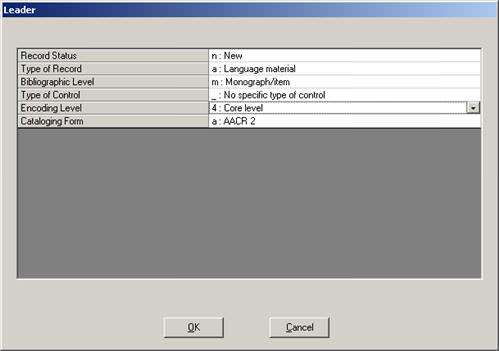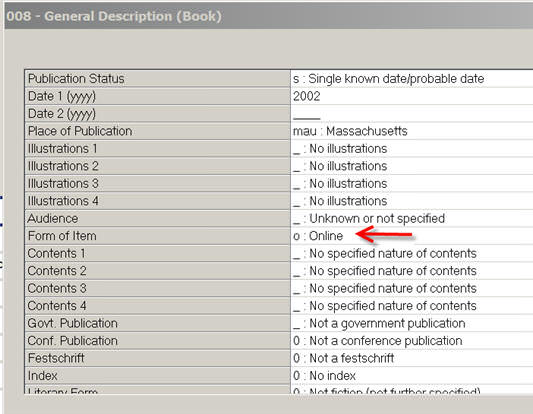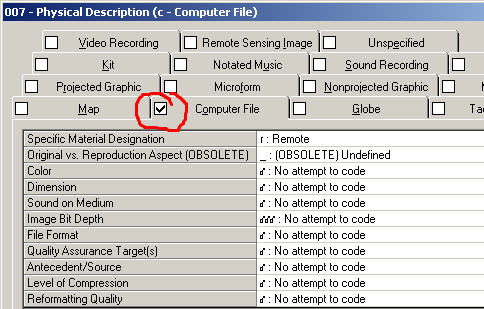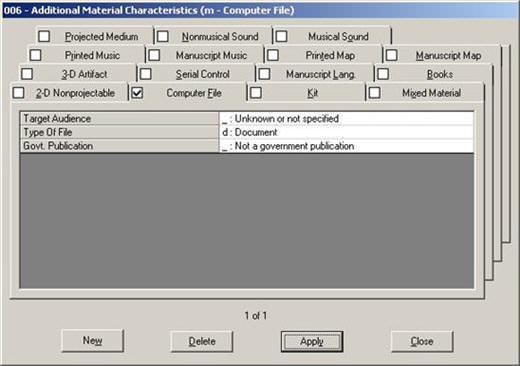Cataloging E-Monographs: Copy Cataloging and Variant Format Cataloging
Introduction
This document [formerly Cataloging Online Books: Reproductions] has been revised to be consistent with General Website Cataloging Policies & Procedures instituted Feb. 2008 & the PCC Guidelines for Provider-Neutral e-Monographs instituted updated in 2013 to be RDA compliant.
SCOPE. Our documentation has separate cataloging guidelines provided for electronic resources depending upon (1) mode of access, (2) mode of issuance, and (3) availability of source copy. The primary focus of this document is on electronic reproductions of monographic works accessed online, or monographic works that are issued concurrently online and in a print version. This document applies if all of the following conditions are met:
- The resource is a remote access electronic resource.
- Accessibility of the resource meets the conditions described in General Website Cataloging Policies & Procedures (items c. & f.) Regarding item f.: conditions are not met if the site requires the user to log on.
- The resource is issued as a monograph. It is not updated.
- Cataloging copy is available for the resource, or there is cataloging copy available for the print version.
These guidelines may be used for updating existing cataloging copy or for creating variant format original cataloging, i.e., creation of a new record in Orbis or OCLC derived from the record for the print version. To simplify processing, as a general rule, if you create an original bibliographic records for an online e-book based on the bibliographic record for another format (usually the original print edition), upgrade the descriptive elements to RDA form. For copy cataloging, if you use the bibliographic record for an online edition, accept whatever cataloging rules were used to create the record, AACR2 or RDA, and do not re-catalog to change from one set of rules to another.
Remote Access vs. Direct Access
Remote access electronic resources are accessed over a computer network such as the Internet. Direct access electronic resources have a physical carrier (AACR2 Appendix D, Glossary). See, for example, Census 2000, Summary File 1, available on DVD (a direct access electronic resource) and (a remote access electronic resource) online. Separate bibliographic records should be created for each format.* Guidelines for cataloging CDs, DVDs, and other direct access electronic resources are available.
Monographs vs. Integrating Resources
Some monographs in print format become integrating resources when issued online because they are continually or frequently updated and updates are integrated into the whole. Compare, for example, Encyclopedia of American Foreign Policy (a monograph) and Wikipedia (an integrating resource). Guidelines for cataloging online integrating resources are available.
Born-Digital vs. Variant Format Cataloging
Based on current PCC guidelines for "provider-neutral" or "P-N" cataloging of online resources, generally consider any online monograph with the same content as the print version* to be a candidate for variant format cataloging, i.e., as an online reproduction of the print original.
Online monographs with no print version counterpart should be cataloged following the PCC guidelines for born-digital cataloging.
*Print version can include: physical printed books, microform, CD-ROM. The print version can pre-date release of the online book or be published simultaneously with the online version.
If an online monograph has a bibliographic record for the print version, the online version should be cataloged using the "separate record"* approach: a bibliographic record for the print version is used as the basis for the creation of a separate bibliographic record for the online monograph.
*In contrast, the "single record" approach has the cataloger add the URL for the online resource to the bibliographic record for the original. YUL policy generally does not allow the single record approach.
If the cataloging is done in Orbis, download an OCLC record for the print version to use as the basis for the e-book record. Be sure to delete the 035 with the OCLC master record number before you save into Orbis from the import file. Be careful not to merge with an existing record already in Orbis.
If there is a record for the print version in Orbis, you can use the Orbis copy command to make a copy of the print version's record to use as the basis for the e-book record. Do not modify the record for the print version!
Before proceeding with cataloging, enter the 856 field into the bibliographic record and test the URL provided by the selector. Verify that the URL meets condition 2. If it does not, contact the selector, acquisitions, or your supervisor as appropriate. Do not proceed with cataloging until condition 2 is met [the resource cannot require payment and the URL must be able to point directly to the title cited in 245]. Note that some sites will allow direct access only after you log on; this does not meet condition 2. Until the issues are resolved, the in-process record should be suppressed.
RELATED DOCUMENTS
PCC Provider-Neutral E-Resource MARC Record Guide: P-N/RDA Combined Version [Word document]
Copy Cataloging e-Books
Checklist
For background, the Variant Format cataloging guidelines for e-books should be reviewed.
See also Copy Cataloging Guidelines on the Fixed Fields (e-Books) page.
See also MFHD and ExportQ page under Variant Format Cataloging (Access Points, MFHD, ExportQ)
245 ‡a. The GMD [computer file] may appear in records created before 2001. Leave the GMD as found on cataloging copy. The GMD will be updated, if necessary, when the record is processed by MARS. If for some reason the cataloging copy lacks ‡h, enter it as [electronic resource].
250. Delete provider-specific edition statements. (Hypothetical example: our link is to the Oxford University Press site, but the record has 250 Brill online ed.) Do not add edition statements for our provider.
256. Leave if found on cataloging copy.
260/264. If the cataloging copy has a different e-book provider in 260, change it to match the publisher statement on the printed version.
300. It is not necessary to add a 300 or modify an existing 300 to the PCC standard. (Some cataloging agencies simply leave off field 300 for online resources; some agencies enter "PDF" in ‡b.
490. If there is a provider series statement, delete it (and the corresponding 830, if there is one). When in doubt whether the series is for a provider or is a true publisher series, retain the series.
588. It is not necessary to add the DBO note. Retain 530 on member copy only if Yale owns the item in the format described in the note. Add the 590 note. There are a number of 5xx fields that are now obsolete when cataloging e-books; they can be left in the record. If a note refers to an online provider that is not ours, delete it.
856. Delete all 856 fields from the cataloging record. Enter the Yale 856 URL following the guidelines above.
6xx. In the copy cataloging workflow, subjects are not checked.
7xx. If there are any 7xxs that are obviously for a provider that is not ours, delete them. Do not add 7xxs for our provider. When in doubt, retain the 7xx.
830. If there is any series that is for a provider that is not ours, delete it. Do not add series for our provider. When in doubt whether the series is for a provider, retain it.
E-books (856)
856 - Electronic Location and Access
Create an 856 field to provide access to the resource.
Generally create and test the 856 field before proceeding with cataloging. Consult with supervisor if the link does not work.
Code the first indicator 4 to specify that the access method is HTTP. Code the second indicator 0 (zero) to specify that the URL provides direct access to the resource described in the body of the record. Enter Online book in subfield y for the link text. In subfield u, copy and paste the URL as it appears either from the search window or the selector e-mail. If the URL changes from session to session, copy the link location by moving the cursor above the link text, right-clicking on the mouse, and selecting Copy Link Location. If the publisher provides a URL for bookmarking or linking, use that.
After saving the record, test the link in the Orbis OPAC, primarily to verify that the URL was transcribed accurately. If the link does not work, or if it does not take you directly to the resource to be described in the bibliographic record (for example, the link sends you to a website portal or requires a log in by the user), or if the resource requires payment before the user can access it, do not proceed with cataloging until the access issues are resolved. Until the problem is resolved, suppress the record from the OPAC.
| 245 | 0 | 0 | ‡a Between grammar and lexicon / ‡c edited by Ellen Contini-Morava, Yishai Tobin. |
| 856 | 4 | 0 | ‡y Online book ‡u <URL> |
Copy Cataloging Guidelines. Delete all 856 fields from the cataloging record. Enter the Yale 856 URL following the guidelines above.
Variant Format Cataloging (Variable Fields: General Editing, 020-050)
Variable Fields
Do not retain bibliographic data for the original in the following fields:
- 010 - LCCN
- 035 - System Number
- 040 - Cataloging Source
- 079 - Post-reclamation Master Record ID for the print version
Retain bibliographic data appropriate to the work being reproduced in the following areas:
- 245 - Title Area
- 250 - Edition Area
- 264 - Publication Area (re-tag to 264 _1 if the print record uses 260)
- 6XX - Subjects
- 7XX - Added Entries
- 4XX/830 - Series
Verify that the subjects are authorized. Provide additional bibliographic data for the e-book, as instructed below.
In some examples, an 856 link is provided. Follow the link provided in the 856 field to examine the resource being described. The text <URL> is used in place of the URL that would appear in the record.
020 - ISBN
Replace the print ISBN with the e-ISBN. Add the ISBN for the print version in a second 020 in ‡z if the publisher has included the print ISBN on the e-monograph. If it is unclear whether the ISBN applies to the e-version or the print-version, enter the ISBN in ‡a. The following example is from a vendor-supplied record derived from OCLC. The vendor stripped off the 13-digit ISBN but retained the qualifier for the 10 digit number; the retention of the form qualifier should be sufficient verification that the number should be entered in 020 ‡a.
| 020 | ‡a 0585052956 (electronic book) | ||
| 245 | 1 | 0 | ‡a Bhagavad-Gita, or, Song celestial / ‡c by Hindu sources ; translated by Sir Edwin Arnold. |
| 856 | 4 | 0 | ‡y Online book ‡u <URL> |
040 - Cataloging Source
The cataloger should replace the data in the 040 as indicated in the example. Use a macro to ensure accuracy.
As far as the utilities and our statistics are concerned, variant edition cataloging is original cataloging.
| 040 | ‡a CtY ‡b eng ‡e rda ‡c CtY | ||
| 100 | 1 | ‡a Graham, Fiona ‡q (Fiona Caroline), ‡e author. | |
| 245 | 1 | 0 | ‡a Inside the Japanese company / ‡c Fiona Graham. |
| 856 | 4 | 0 | ‡y Online book ‡u <URL> |
050 - Library of Congress Call Number
Retain from existing copy. The first indicator should be blank. The second indicator should be coded 4. Leave out ‡b and anything to the right of ‡b. In the absence of a 050, an 090 may be used as the source for the classification number. (Use 050 _4 to enter the 090 class number)
| 040 | ‡a CtY ‡b eng ‡e rda ‡c CtY | ||
| 050 | 4 | ‡a DG253.S4 | |
| 100 | 1 | ‡a Astin, A. E. | |
| 245 | 1 | 0 | ‡a Scipio Aemilianus / ‡c by A.E. Astin. |
| 856 | 4 | 0 | ‡y Online book ‡u <URL> |
If a class number is not readily available, do not supply one.
Variant Format Cataloging (Variable Fields: 245-5xx)
245/246 - Title/Variant Title
Some obsolete AACR2 practices need to be modified when creating a new record:
- Under RDA, the GMD (general material designator, ‡h [electronic resource]) is not used. Do not enter a GMD in 245.
- If the print record used the "rule of 3" in the statement of responsibility, replace "... [et al.]" with the names of the other authors. The first author named should be moved to the 100 field from the 700 field of the print record. Do not consider editors to be authors; they continue to be entered in 700.
- Supplied "other titles" (245 ‡b) in brackets should be removed. However, bracketed words used for clarification in 245 ‡c are still OK under RDA.
- Bracketed "[sic]" should be removed. If the "[sic]" applies to something in 245 ‡a, enter the corrected form of ‡a in 246.
- AACR2 replaces ellipses (...) with a dash (--). If your title source has ellipses, transcribe the ellipses; do not replace with a dash.
| 245 | 0 | 0 | ‡a Struggles in the promised land : ‡b toward a history of Black-Jewish relations in the United States / ‡c edited by Jack Salzman & Cornel West. |
| 856 | 4 | 0 | ‡y Online book ‡u <URL restricted by licensing agreement> |
| 245 | 0 | 0 | ‡a Psalterion = ‡b Psalterium : juxta exemplar Alexandrinum. |
| 856 | 4 | 0 | ‡y Online book ‡u URL |
| 245 | 1 | 0 | ‡a Canada. ‡n Part II, ‡p the history from 1763-1921 / ‡c by Hugh E. Egerton. |
| 856 | 4 | 0 | ‡y Online book ‡u <URL> |
If the e-monograph has source copy but the e-version has additional variant titles, enter the variants in 246 1_.
| 100 | 1 | ‡a Brooks, Charles J., ‡e author. | |
| 245 | 1 | 0 | ‡a A+ certification training guide / ‡c Charles J. Brooks. |
| 246 | 1 | ‡a A+ training guide. | |
| 246 | 1 | ‡i Available from some providers with title: ‡a A plus training guide | |
| 856 | 4 | 0 | ‡y Online book ‡u <URL access restricted by licensing agreement> |
In general, retain 246 fields that were on the print record. Re-tag them to 246 1_ -- in some systems, the indicators on the original record may generate labels referring to the physical book.
Make additional 246 fields for variant forms of the title found on the e-version if they would aid in retrieval of the record. Tag these as 246 1_‡i Available from some providers with title: ‡a <title>
Do not end 246 with a period.
If there is no source copy for the printed resource on which to base the online record, the cataloging does not fall into the online reproduction category. The online e-monograph in that case should be cataloged as born-digital original cataloging, a different workflow.
250 - Edition
Retain the edition statement for the print edition, but do not add edition statements for the online provider. If the record for the print original was cataloged following AACR2 rules, some cataloger supplied abbreviations may have been used. If the original edition statement is reproduced in the online resource (e.g., on a title page image captured on PDF), transcribe it as it appears with no supplied abbreviations.
256 - Computer File Characteristics
This field is obsolete. File characteristics are described in a note.
264 - Publisher Statement
Based the publisher statement on the original printed version, but change the tag from 260 __ to 264 _1. If the online source has an image of the publisher statement (on PDF), replace any supplied abbreviations with the spelled-out form as found in the statement, including state abbreviations in brackets in 246 ‡a.
300 - Physical Description
Replace the print version's 300 with a 300 for the e-version. Always begin with 1 online resource. Add pagination in parentheses only if the e-book has pagination. Go with the last numbered page; it is not necessary to include plates in the numbering. Add ‡b only if appropriate--don't assume that if the print version has illustrations the e-book will, or that if the print version illustrations are color the e-book illustrations are color. Do not enter "PDF" in ‡b. Do not make or keep a ‡c or a ‡e. If there is no closing punctuation, end the field with a period.
| 300 | ‡a 1 online resource :‡b illustrations. |
| 300 | ‡a 1 online resource (325 pages) |
| 300 | ‡a 1 online resource (100 pages) : ‡b illustrations (some color) |
336-337-338 Content, Media, and Carrier Type MARC Fields
The AACR2 GMD is somewhat replaced by the new MARC fields. They do not display but are keyword indexed. These need to be added to the new record for the online resource. A macro can easily be derived from the one used for printed material. The MARC fields for e-books will look like this:
| 336 | ‡a text ‡2 rdacontent | ||
| 337 | ‡a computer ‡2 rdamedia | ||
| 338 | ‡a online resource ‡2 rdacarrier |
490 -- Series
Retain series statements from the print edition, including the print ISSN (‡x).
5XX - Notes
Notes that apply only to the original can be left as is.
Add the following notes.
530 - Other Formats Note
In general, do not make a 530 (available in other formats) note. If cataloging is done on OCLC, use the PCC guidelines and make a 776 field rather than a 530.
588 Description based on
NEW: As the second to the last note (assuming there is a last 590 note), make a DBO note for the version used as the cataloging source. As of Oct. 1, 2011, use 588 __ instead of 500 for the DBO notes for e-monographs. Continue to use 500 for cataloging the print version.
| 588 | ‡a Description based on print version. |
| 588 | ‡a Description based on microfilm version. |
590 -- Local Note
Add a local note on access unless the e-book is not licensed. Enter 590 as the last note.
| 590 | ‡a Access is available to the Yale community. |
5XX OBSOLETE
Per the PCC guidelines, the following notes formerly used in e-book cataloging are now obsolete:
500/540. Notes about the e-book provider(s).
506 [Access restricted by licensing agreement]
516 [Type of computer files, e.g. Images, text.]
533. Reproduction note.
538. Mode of access: World Wide Web.
540. Terms of use.
583. Action note.
Variant Format Cataloging (Access & Linking Fields, MFHD, ExportQ)
Access Points
Check subject (6XX), name (1XX/7XX), title (7XX), and series (4XX/830) headings against the authority file for currency and accuracy.
Delete subjects with the subdivision --Specimens.
7XX - Title Added Entries and Linking Entries
Do not make added entries for the provider.
If cataloging on OCLC, make a 776 linking field to the OCLC record for the print version. For the time being, cataloging in Orbis will not make the 776 linking field.
For OCLC instructions in using the Insert from Cited Record command, click here and use Find in Page to search "Insert from Cited Record."
830 - Series Added Entries
Retain series added entries for the print series. Generally it is not necessary to make series added entries for the e-version unless the publisher is also the provider. When in doubt, do not make a distinct series added entry for the e-version; the 830 for the printed series is considered sufficient.
MFHD <new location code>
In the MFHD, create an 852 field with first indicator 8 and second indicator 0 (zero). Enter the location code yulintx for Yale Internet Resource in subfield b. Do not provide a call number in subfield h; simply enter None. Add Online resource as a public note in subfield z. Formerly, the location code for all online resources was yulint; yulint is now used only with vendor supplied cataloging, which cannot be exported to OCLC. When YUL catalogs the records, we want them to be exported to OCLC; location code yulintx will be flagged for export once it has returned from MARS.
| 852 | 8 | 0 | ‡b yulintx ‡h None ‡z Online resource |
ExportQ
Upon completion of cataloging, export the bibliographic record to MARS by clicking Send in the ExportQ window with the bibliographic record open.
If there special copyright restrictions on the e-version, use yulint rather than yulintx. There should be a note with the selector cataloging request regarding any restrictions on access. It's not expected that it will happen frequently. Enter a note in 948 if it cannot be exported.
948 __ ‡a DO NOT EXPORT
Fixed Fields (e-Books)
Fixed Fields
Leader

Supply a value for Type of Record that reflects the predominant content of the resource. Online books should be coded a (Language material) even when they include search software and hyperlinks.
Since online resources are considered published (formerly AACR2 9.4B2), do not use codes for manuscript material. For example, an online dissertation is coded a (Language material) rather than t (Manuscript language material).
When cataloging on Orbis, use Encoding Level <blank>.
CAUTION. When cataloging on OCLC, use E/Lvl I.
Variant Format Cataloging
008 - General Description

The value supplied for Type of Record in the leader triggers the type of 008. For online books, that type is Book.
Click the 008 button. When necessary, provide or change the coding when necessary for: Publication Information, Form of Item, Language, Modified Record Code, and Cataloging Source. Retain publication information for the print version, and verify that it describes the source of the e-monograph being cataloged. For example, if the record for the print version describes a revised edition, the content for the e-monograph should be for the same revised edition. Form of Item should always be coded o (Online) [formerly coded s Electronic Resource). Modified Record Code should be coded _ (Not modified). Cataloging Source should be coded d (Other).
007 - Physical Description

Create an 007 to describe the physical medium of the resource.
Click the 007 button, select the Computer file tab, and click New. Specific Material Designation is always coded r (Remote). No Attempt to Code should be selected for the other fields.
006 - Additional Material Characteristics

Create a 006. Click the 006 button, select the Computer File tab, and click New. For ebooks, Type of File should be coded d (Document). Target audience can be unknown or | No Attempt to Code. Code the Govt Publication field as applicable.
Copy Cataloging Policy:
- Accept the leader coding as given on cataloging copy with one exception: the Type of Record must be a [language material] not m [computer file]; this may have an impact on retrieval. If it is necessary to change the Type of record code, other fixed fields will need to be filled in. For online dissertations use Type of Record a rather than t.
- Verify that the 008 Form of Item code is o [If the Form of Item is coded s; change to o]
- Always create an 007 for c (Computer file) if not found on cataloging copy.
- It is not necessary to create a 006.
- Otherwise leave the fixed fields as is.
- When searching, prefer a record with the codes used in current cataloging, all things being equal.